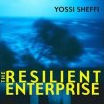 What is at the forefront of current research in supply chain management and logistics right now? I know, thanks to to Gyöngi Kovács at interorganisational.org, who attended the NOFOMA 2009 conference a couple of days ago. At the conference, Emerald, one of the world’s leading publishers of management journals, presented some statistics on which articles that were most downloaded from their online journals during the first quarter of 2009. Update: To read what the latest trends are in 2011 and which forces that are expected to be a major trend towards 2020, please see my post on Future Value Chains and Strategies for 2020.
What is at the forefront of current research in supply chain management and logistics right now? I know, thanks to to Gyöngi Kovács at interorganisational.org, who attended the NOFOMA 2009 conference a couple of days ago. At the conference, Emerald, one of the world’s leading publishers of management journals, presented some statistics on which articles that were most downloaded from their online journals during the first quarter of 2009. Update: To read what the latest trends are in 2011 and which forces that are expected to be a major trend towards 2020, please see my post on Future Value Chains and Strategies for 2020.
Top of the pops
Why are downloads interesting? As more and more journals go online, the number of downloads an article has measures how popular or sought after an article is. Downloads are interesting because they not only reveal what is read but also which topics academics currently work on or what ‘previous’ and ‘published’ research they use in their current work. So what DO academics work on? Mind you, the list is based on the Emerald statistics for IJLM, IJPDLM and SCM:IJ, so it is highly selective and highly biased, and thus not fully representative. Nonetheless, it does suggest that some themes have a higher readership than others:
- Supply chain risk management
- Christopher & Lee (2004)
Mitigating supply chain risk through improved confidence
- Christopher & Lee (2004)
- Supply chain integration and collaboration
- Pålsson & Johansson’s (2009)
Supply chain integration obtained through uniquely labelled goods
- Pålsson & Johansson’s (2009)
- Corporate social responsibility, ethics, and green/reverse supply chains
- Hanafi et al. (2008)
Reverse logistics strategies for end-of-life products
- Hanafi et al. (2008)
- Lean and agile supply chains
- Masson et al. (2007)
Managing complexity in agile global fashion industry supply chains
- Masson et al. (2007)
- E-commerce
- RFID
- Spekman &Sweeney (2006)
RFID: from concept to implementation
- Spekman &Sweeney (2006)
I am not at all surprised that corporate responsibility and green/reverse logistics rank high on the list, and they are certainly not going to be less popular in the future. Update: To read what the latest trends are in 2011 and which forces that are expected to be a major trend towards 2020, please see my post on Future Value Chains and Strategies for 2020.
Other hotbeds
Several other fields also make an impact, and again, no surprises here:
- Value chain analysis
- Humanitarian logistics
- Demand management
- Logistics outsourcing
- Warehousing and inventory management
- Transportation
- Implementation of SCM
You may also be interested in Hameri and Hintsa (2009) and what they wrote about trends and drivers for international supply chains.
And the trend?
Well, quoting Gyöngi,
Integration, CSR, risk management, even humanitarian logistics were already hot topics the last time we looked at them. Optimisation doesn’t make the list any more – though that can be due to the convenience sample of these very journals. The same goes for customisation and modularisation, and supply chain design. “Global” this and that has been dropped.
So now you know what to research, if you want to be in the hot seat.
And I have a lot of reading to do…
Reference
Pålsson, H., & Johansson, O. (2009). Supply chain integration obtained through uniquely labelled goods: A survey of Swedish manufacturing industries International Journal of Physical Distribution & Logistics Management, 39 (1), 28-46 DOI: 10.1108/09600030910929174
Christopher, M., & Lee, H. (2004). Mitigating supply chain risk through improved confidence International Journal of Physical Distribution & Logistics Management, 34 (5), 388-396 DOI: 10.1108/09600030410545436
Hanafi, J., Kara, S., & Kaebernick, H. (2008). Reverse logistics strategies for end-of-life products The International Journal of Logistics Management, 19 (3), 367-388 DOI: 10.1108/09574090810919206
Masson, R., Iosif, L., MacKerron, G., & Fernie, J. (2007). Managing complexity in agile global fashion industry supply chains The International Journal of Logistics Management, 18 (2), 238-254 DOI: 10.1108/09574090710816959
Cho, J., Ozment, J., & Sink, H. (2008). Logistics capability, logistics outsourcing and firm performance in an e-commerce market International Journal of Physical Distribution & Logistics Management, 38 (5), 336-359 DOI: 10.1108/09600030810882825
Spekman, R., & II, P. (2006). RFID: from concept to implementation International Journal of Physical Distribution & Logistics Management, 36 (10), 736-754 DOI: 10.1108/09600030610714571
Links
- interorganisational.org: Trendspotting
Related
- husdal.com: Future Value Chains for 2020
- husdal.com: Trends and drivers for cross-border supply chains
- husdal.com: NOFOMA












